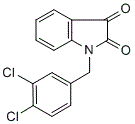All AbMole products are for research use only, cannot be used for human consumption.

MDK83190 is a potent apoptosis activator, induces Apaf-1 oligomerization, increases procaspase-9 processing and subsequent caspase-3 activation in a cyto c-dependent manner. MDK83190 (Apoptosis Activator 2) strongly induces caspase-3 activation, PARP cleavage, and DNA fragmentation which leads to the destruction of cells (Apaf-1 dependent) with IC50 of ~4 μM, inactive to HMEC, PREC, or MCF-10A cells. MDK83190 promotes apoptosome formation and activates caspase-9/caspase-3 pathway. MDK83190 selectively induces tumor cell apoptosis.

Cell Death Dis. 2024 Feb;15(2):129.
Deubiquitinase Mysm1 regulates neural stem cell proliferation and differentiation by controlling Id4 expression
MDK83190 purchased from AbMole
| Molecular Weight | 306.14 |
| Formula | C15H9Cl2NO2 |
| CAS Number | 79183-19-0 |
| Solubility (25°C) | DMSO 30 mg/mL |
| Storage |
Powder -20°C 3 years ; 4°C 2 years In solvent -80°C 6 months ; -20°C 1 month |
[1] Su-Been Lee, et al. Induction of p53-Dependent Apoptosis by Prostaglandin A 2
[4] Vitaliy O Kaminskyy, et al. Free radicals in cross talk between autophagy and apoptosis
| Related Caspase Products |
|---|
| Z-VAD
Z-VAD is a competitive, irreversible pan-caspase inhibitor. Z-VAD inhibits all 10 caspases, except for caspase-2 which is only weakly inhibited. Z-VAD decreases radiation-induced apoptosis. |
| PEAQX
PEAQX (NVP-AAM077) is an orally active and selective NMDA antagonist, with IC50 values of 270 nM and 29.6 μM for hNMDAR 1A/2A and hNMDAR 1A/2B, respectively. |
| MMPSI
MMPSI is a potent and selective small molecule caspase 3 and caspase 7 inhibitor with an IC50 of 1.7 μM for human caspase-3. |
| Ivachtin
Ivachtin (Caspase-3 Inhibitor VII; compound 7a) is a nonpeptide, noncompetitive and reversibl caspase-3 inhibitor with an IC50 of 23 nM. |
| VMY-1-103
VMY-1-103 is an inhibitor for cyclin/Cdk complex, that arrests the cell cycle at G1 phase. |
All AbMole products are for research use only, cannot be used for human consumption or veterinary use. We do not provide products or services to individuals. Please comply with the intended use and do not use AbMole products for any other purpose.


Products are for research use only. Not for human use. We do not sell to patients.
© Copyright 2010-2024 AbMole BioScience. All Rights Reserved.
